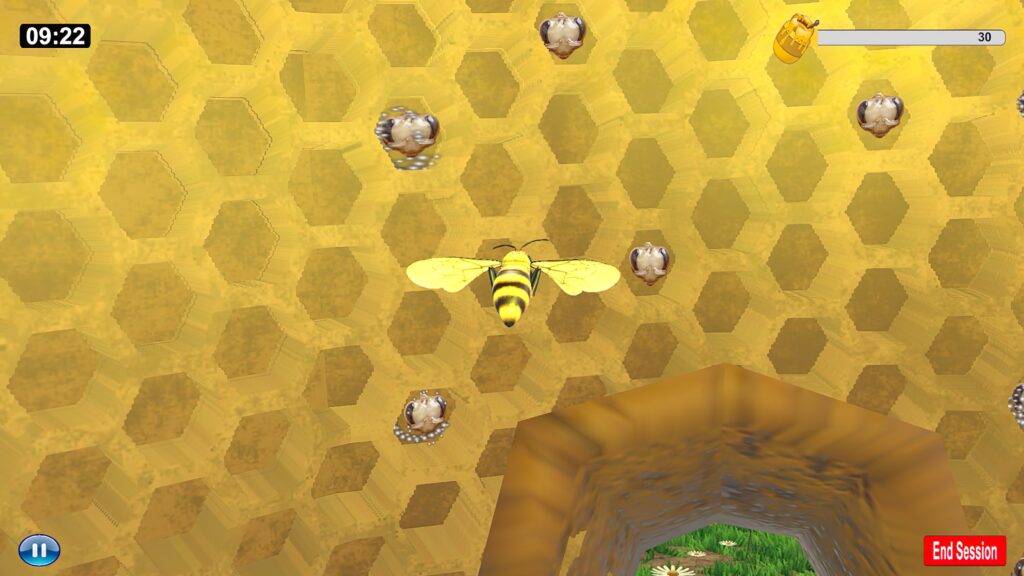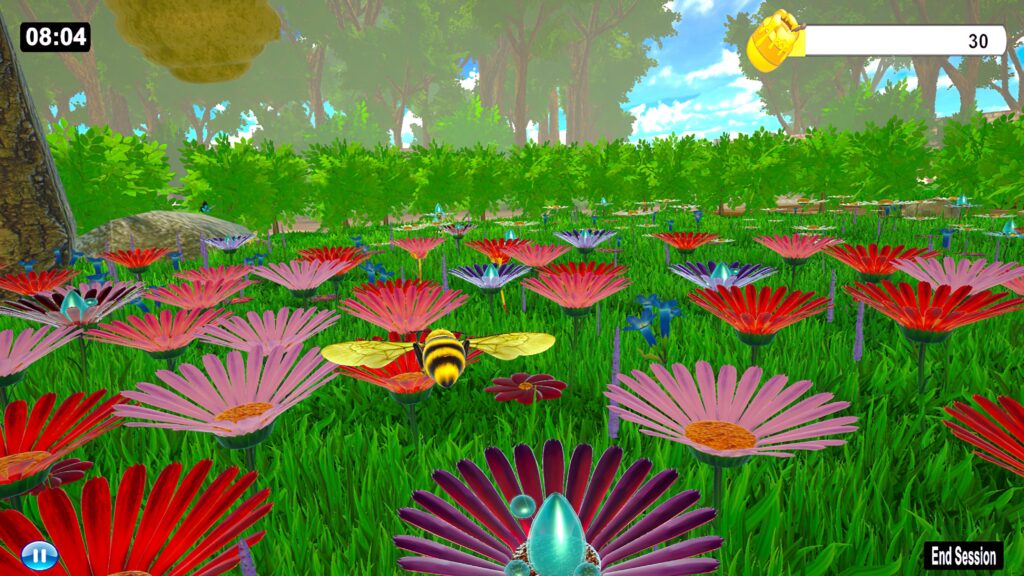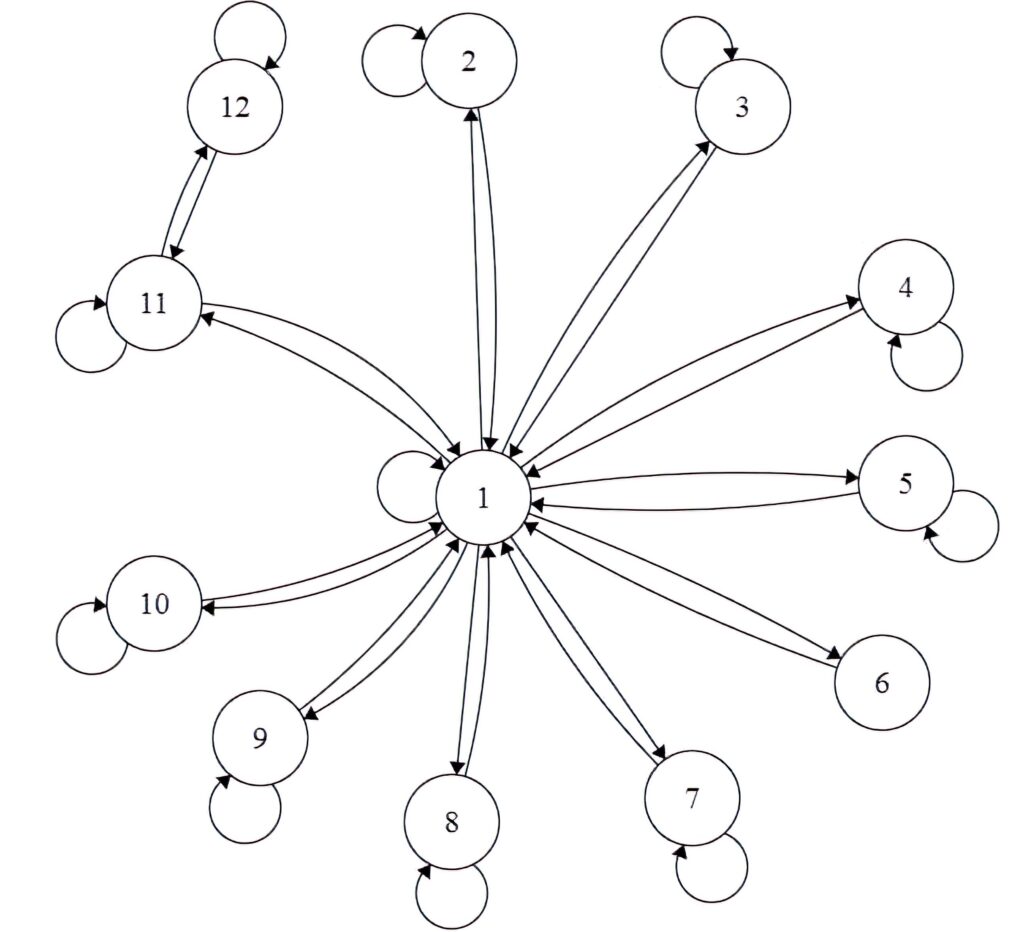A serious game based on bees was developed for the hand and wrist rehabilitation of individuals with Parkinson’s disease (PD). First of all, the bee is a popular animal, well known to everyone, and it is very important for the ecosystem. In addition, bees represent work, effort and dedication, characteristics that are highly demanded of patients with PD during the rehabilitation process. In this way, the serious game was named RehaBEElitation, associating the name of the animal with the word rehabilitation, in English.
Unity 3D software was used to build game scenarios, object interactions and animations. The modeling of the game objects was done in Blender 3D, a software commonly used for modeling, animation, texturing, compositing and rendering. Finally, the game’s control panel was developed in the C# language using Visual Studio 2019.
To fulfill the objectives of the game, the user must control the movements of a bee in a 3D environment. The game tasks were designed to mimic the following movements found in the reference tool for the assessment of individuals with PD (MDS-UPDRS Part III): hand opening and closing, hand extension and flexion, hand adduction and abduction, finger tapping, and forearm supination and pronation. The game consists of four phases (Fig. 1), whose objectives are:
- Phase 1: Pollinating the flowers – The objective is to collect pollen from one flower and pollinate another flower. Flowers that have pollen to collect are indicated by yellow arcs around them, and those that need to be pollinated are indicated by green arcs. The player must move the bee to a flower containing pollen and close the hand to catch it. Then, with the hand closed, the player must move the bee to a flower that does not have pollen and open the hand to deposit it.

- Phase 2: Feeding the larvae – The objective is to feed the larvae. To address the larvae, the player must extend and flex the hand to raise and lower the bee, respectively, and adduct and abduct the hand to move the bee to the left and right, respectively (if playing with the right hand). A larvae will be fed when the player places the bee in front of him.

- Phase 3: Collecting the nectar – The objective is to collect nectar from flowers. Flowers that have nectar are indicated by drops of water. The player must guide the bee to a flower that has nectar and perform the finger tapping movement to collect the nectar.

- Phase 4: Drying the nectar – The objective is to dry the nectar in order to produce honey. The player must go to honeycombs containing nectar (indicated by a luminous reflection) and perform a supination and pronation movement of the forearm to make the bee flap its wings faster and dry the nectar.

The moves highlighted in each stage, as well as the moves made by the player that correspond to those made by the bee in the game are shown below.
| Phases | Main Movement | Movement Representation | Action performed |
| Phase 1 : Pollinating flowers | Hand closing Hand opening |   | Collect pollen from flowers Deposit pollen in flowers |
| Phase 2 : Feeding the larvae | Hand extension Hand flexion Hand adduction Hand abduction |    | Move the bee up Move the bee down Move the bee to the left (if playing with right hand) Move the bee to the right (if playing with right hand) |
| Phase 3 : Collecting the nectar | Finger tapping |  | Collect nectar from flowers |
| Phase 4 : Drying the nectar | Forearm supination Forearm pronation |  | Flap the bee’s wings |
There are nine different levels of difficulty in the game. The characteristics of the game that change according to the difficulty level are: the number of targets that must be reached by the player; the maximum time of the phase; and the speed of movement of the bee. In addition, for every hit the player makes, 10 points will be added to his score.
From the data sent by the glove to the game, there are 12 possible states and each one is related to the movement of the bee in the game, as shown in the following table.
| State | HMI movement | Bee movement |
| 1 | Rest | Stop |
| 2 | Extension – Open Hand | Up |
| 3 | Flexion – Open Hand | Down |
| 4 | Abduction – Open Hand | To the left |
| 5 | Adduction – Open Hand | To the right |
| 6 | Finger tapping | Collecting nectar |
| 7 | Extension – Closed Hand | Up and carrying pollen |
| 8 | Flexion – Closed Hand | Down and carrying pollen |
| 9 | Abduction – Closed Hand | To the left and carrying pollen |
| 10 | Adduction – Closed Hand | To the right and carrying pollen |
| 11 | Pronation | Increases wing speed |
| 12 | Supination | Decreases wing speed |
In this way, the state machine of RehaBEElitation shows all possible transitions between the 12 states.

The player starts in state 1, and from there, can go to any of the other states. There is always a return to state 1 before going to another state. For example, if the player wants to move the bee down and to the left, he/she must first perform hand flexion, return to the resting state and then perform hand adduction (if playing with the right hand).

